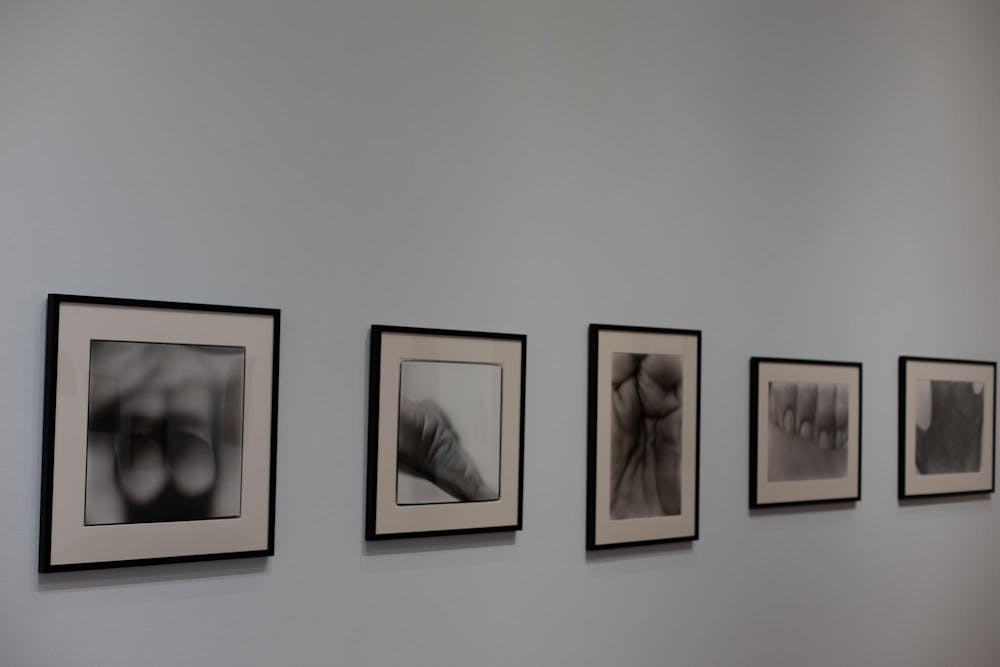Striking tones of black and white images illuminate the walls of the Fralin Museum of Art as the exhibition titled “Holly Wright: Vanity” sits in its new temporary home in Charlottesville. First opened at the Fralin Aug. 31, Holly Wright’s photography series — which brings together selections from three bodies of work, “Final Portraits,” “Vanity” and “Poetry” — dissects the intricacies of communication and the impermanence of life through close-up and full-length stills of the human body.
Wright, who taught photography at the University from 1984 to 2000, was one of the pioneering forces behind establishing a photography collection at the museum. Though her work has been displayed at various institutions such as the Metropolitan Museum of Art and the Yale University Art Gallery, this is her first solo exhibition to be featured at the Fralin. Fittingly, the exhibit was made possible through the funding and support of one of Wright’s former students, Tom Osborne.
The exhibit's preoccupation with expression, particularly self-expression, through the lens of photography can be understood best through the titular series “Vanity,” a collection of zoomed-in images of Wright’s hands. Dr. Kristen Nassif, curator of collections at the Fralin, said this focus adds a level of abstraction to the collection’s examination of the human body, with visuals that are initially somewhat difficult to decipher.
“She called the series ‘Vanity’ because she thought it was really vain to turn the camera on herself and photograph herself,” Nassif said. “But I think that she found a really kind of creative and effective way to take these abstracted images of her body.”
Through the thematic exploration of expression, Wright explores the challenges of understanding identity by choosing to focus her lens on overlooked aspects of the human experience. This is especially evident in the second series of photos titled “Poetry,” in which Wright captures the mouth of her husband — Charles Wright, a retired English professor at the University who also served as the 20th Poet Laureate of the United States — in the act of reciting a poem.
The images in this series are organized in a grid, creating a pictorial narrative that visually represents the poetic prose. Each image connects with the previous, actualizing the unconfined movement of speech. When seen as a whole, the collage asks viewers to focus on the architecture of the mouth, rather than the words being said. Through this focus, Wright reframes the significance of how individuals choose to convey meaning beyond language — through the nuances of articulation.
Given the significance of the “Poetry” segment’s presentation of its message, it should come as no surprise that Wright played an active role in curating the exhibit. Nassif said she enjoyed the opportunity to collaborate with Wright during this process.
“When Holly came on site, she helped us kind of arrange them into this flowing rhythm of panels, which I think is really beautiful because it kind of mimics inflections and sentences and the pacing of sentences,” Nassif said.
In the third series, entitled “Final Portraits,” images of couples and individuals lying flat on their backs populate the Fralin’s octagonal gallery room. What sets this series apart is the question guiding the models’ poses — “if you could take one photograph before you passed on, what would it look like?”
According to an installment of the Fralin’s Writer’s Eye Spotlight Talk series, Wright’s vision for this series stemmed from the phenomenon of wealthy individuals who commission portraits of themselves to be included at their final resting place. In positioning the models in similar stages of mortality, viewers are encouraged to ask themselves the same question and reflect on their own relationship with death and legacy.
The Fralin currently displays the paintings on the gallery walls, but Ariel Ankrah, curatorial assistant at the Fralin and Class of 2023 alumna, said that while drafting the design of the exhibit, Wright initially wanted to have her photographs laid out on the ground to make the arrangement more interactive.
“One of the concepts Holly wanted to have when we originally started talking to her about the exhibition is she wanted people to be able to walk on the final portraits, like [to] have them on the ground,” Ankrah said. “Sort of like you're walking on the body of a loved one, or like if you were in a cemetery.”
While this idea never came to fruition because of limitations in the Fralin’s layout, its concept speaks to Wright’s overall desire for the exhibit to engage viewers with the ideas of mortality and discomfort, which she achieves through variation with representations of the models and experimentation with levity and depth in each image.
When viewed as a whole, “Vanity,” “Poetry” and “Final Portraits” work together to ask questions about the nature of humanity and the meaning of human connection. Nassif said that each series is designed to build upon the previous one, with the goal of pushing the limits of photography as a medium.
“I think she's really interested in playing with what photography can do,” Nassif said. “So both [the] literal representation of people, but also, [the] abstracted representations of the body.”
More broadly, Wright’s work speaks to the intricacies of life — from exploring the self in “Vanity,” to unsaid communication in “Poetry,” to confronting death and connectivity in “Final Portraits.” Through “Holly Wright: Vanity,” the Fralin honors a major contributor to the arts at the University.
The exhibition, which is open to all art enthusiasts, will continue to run in the Fralin Museum until Jan. 5. The museum’s hours can be accessed on their website.







